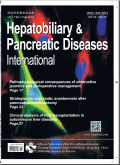- 钛学术文献服务平台 \
- 学术期刊 \
- 医药卫生期刊 \
- 内科学期刊 \
- 国际肝胆胰疾病杂志(英文版)期刊 \
null
Small-for-size syndrome in liver transplantation: Definition, pathophysiology and management
基本信息来源于合作网站,原文需代理用户跳转至来源网站获取
摘要:
Background: Since the first success in an adult patient, living donor liver transplantation (LDLT) has be- come an universally used procedure. Small-for-size syndrome (SFSS) is a well-known complication after partial LT, especially in cases of adult-to-adult LDLT. The definition of SFSS slightly varies among trans- plant physicians. The use of a partial liver graft has risks of SFSS development. Persistent portal vein (PV) hypertension and PV hyper-perfusion after LT were identified as the main factors. Hence, various approaches were explored to modulate PV flow and decrease PV pressure in order to alleviate this syn- drome. Herein, the definition, clinical symptoms, pathophysiology, basic research, as well as preventive and treatment strategies for SFSS are reviewed based on an extensive review of the literature and on our own experiences.Data sources: The articles were collected through PubMed using search terms "liver transplantation", "liv- ing donor liver transplantation", "living liver donation", "partial graft", "small-for-size graft", "small-for- size syndrome", "graft volume", "remnant liver", "standard liver volume", "graft to recipient body weight ratio", "sarcopenia", "porcine", "swine", and "rat". English publications published before March 31, 2020 were included in this review. Results: Many transplant surgeons performed PV flow modulation, including portocaval shunt, splenic artery ligation and splenectomy. With these techniques, patient outcome has been improved even when using a "small" graft. Other factors, such as preoperative recipients' nutritional and skeletal muscle status, graft congestion, and donor factors, were also identified as risk factors which all have been addressed using various strategies. Conclusions: The surgical approach controlling PV flow and pressure could help to prevent SFSS espe- cially in severely ill recipients. In the absence of efficacious medications to resolve SFSS, conservative treatments, including aggressive fluid balance correction for massive ascites, anti-microbiological ther- apy to prevent or control sepsis and intensive nutritional therapy, are all required if SFSS could not be prevented.

推荐文章
期刊_丙丁烷TDLAS测量系统的吸收峰自动检测
带间级联激光器
调谐半导体激光吸收光谱
雾剂检漏 中红外吸收峰 洛伦兹光谱线型
不同盐度、温度及光照对漂浮浒苔生理生态的影响
浒苔
盐度
温度
光照
生理生态
期刊_联合空间信息的改进低秩稀疏矩阵分解的高光谱异常目标检测
高光谱图像
异常目标检测 低秩稀疏矩阵分解 稀疏矩阵 残差矩阵
内容分析
关键词云
关键词热度
相关文献总数
(/次)
(/年)
文献信息
| 篇名 | Small-for-size syndrome in liver transplantation: Definition, pathophysiology and management | ||
| 来源期刊 | 国际肝胆胰疾病杂志(英文版) | 学科 | |
| 关键词 | |||
| 年,卷(期) | 2020,(4) | 所属期刊栏目 | |
| 研究方向 | 页码范围 | 334-341 | |
| 页数 | 8页 | 分类号 | |
| 字数 | 语种 | 英文 | |
| DOI | |||
五维指标
引文网络
引文网络
二级参考文献 (182)
共引文献 (8)
参考文献 (109)
节点文献
引证文献 (0)
同被引文献 (0)
二级引证文献 (0)
1900(2)
- 参考文献(0)
- 二级参考文献(2)
1969(1)
- 参考文献(1)
- 二级参考文献(0)
1975(1)
- 参考文献(0)
- 二级参考文献(1)
1988(1)
- 参考文献(0)
- 二级参考文献(1)
1989(1)
- 参考文献(0)
- 二级参考文献(1)
1990(2)
- 参考文献(0)
- 二级参考文献(2)
1992(1)
- 参考文献(1)
- 二级参考文献(0)
1993(3)
- 参考文献(1)
- 二级参考文献(2)
1994(4)
- 参考文献(1)
- 二级参考文献(3)
1995(4)
- 参考文献(2)
- 二级参考文献(2)
1996(3)
- 参考文献(2)
- 二级参考文献(1)
1997(2)
- 参考文献(0)
- 二级参考文献(2)
1998(2)
- 参考文献(1)
- 二级参考文献(1)
1999(9)
- 参考文献(3)
- 二级参考文献(6)
2000(6)
- 参考文献(0)
- 二级参考文献(6)
2001(15)
- 参考文献(5)
- 二级参考文献(10)
2002(12)
- 参考文献(8)
- 二级参考文献(4)
2003(21)
- 参考文献(10)
- 二级参考文献(11)
2004(15)
- 参考文献(6)
- 二级参考文献(9)
2005(13)
- 参考文献(6)
- 二级参考文献(7)
2006(9)
- 参考文献(4)
- 二级参考文献(5)
2007(6)
- 参考文献(3)
- 二级参考文献(3)
2008(13)
- 参考文献(5)
- 二级参考文献(8)
2009(14)
- 参考文献(6)
- 二级参考文献(8)
2010(12)
- 参考文献(4)
- 二级参考文献(8)
2011(8)
- 参考文献(1)
- 二级参考文献(7)
2012(15)
- 参考文献(3)
- 二级参考文献(12)
2013(22)
- 参考文献(7)
- 二级参考文献(15)
2014(22)
- 参考文献(6)
- 二级参考文献(16)
2015(12)
- 参考文献(4)
- 二级参考文献(8)
2016(16)
- 参考文献(9)
- 二级参考文献(7)
2017(12)
- 参考文献(4)
- 二级参考文献(8)
2018(6)
- 参考文献(0)
- 二级参考文献(6)
2019(6)
- 参考文献(6)
- 二级参考文献(0)
2020(0)
- 参考文献(0)
- 二级参考文献(0)
- 引证文献(0)
- 二级引证文献(0)
引文网络交叉学科
相关学者/机构
期刊影响力
国际肝胆胰疾病杂志(英文版)
主办单位:
浙江大学医学院第一附属医院
出版周期:
双月刊
ISSN:
1499-3872
CN:
33-1391/R
开本:
大16开
出版地:
浙江省杭州市庆春路79号
邮发代号:
创刊时间:
2002
语种:
eng
出版文献量(篇)
1879
总下载数(次)
0
总被引数(次)
8662
期刊文献
相关文献
推荐文献
- 期刊分类
- 期刊(年)
- 期刊(期)
- 期刊推荐
国际肝胆胰疾病杂志(英文版)2022
国际肝胆胰疾病杂志(英文版)2021
国际肝胆胰疾病杂志(英文版)2020
国际肝胆胰疾病杂志(英文版)2019
国际肝胆胰疾病杂志(英文版)2018
国际肝胆胰疾病杂志(英文版)2017
国际肝胆胰疾病杂志(英文版)2016
国际肝胆胰疾病杂志(英文版)2015
国际肝胆胰疾病杂志(英文版)2014
国际肝胆胰疾病杂志(英文版)2013
国际肝胆胰疾病杂志(英文版)2012
国际肝胆胰疾病杂志(英文版)2011
国际肝胆胰疾病杂志(英文版)2010
国际肝胆胰疾病杂志(英文版)2009
国际肝胆胰疾病杂志(英文版)2008
国际肝胆胰疾病杂志(英文版)2007
国际肝胆胰疾病杂志(英文版)2006
国际肝胆胰疾病杂志(英文版)2020年第6期
国际肝胆胰疾病杂志(英文版)2020年第5期
国际肝胆胰疾病杂志(英文版)2020年第4期
国际肝胆胰疾病杂志(英文版)2020年第3期
国际肝胆胰疾病杂志(英文版)2020年第2期
国际肝胆胰疾病杂志(英文版)2020年第1期

 免费查重
免费查重










